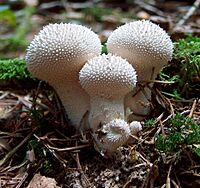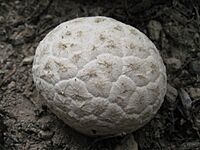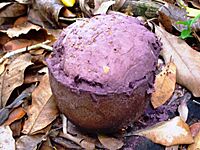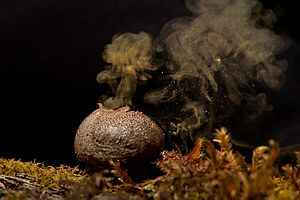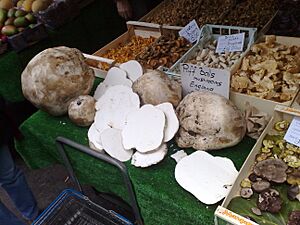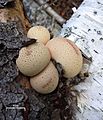Puffball facts for kids
Puffballs are a fascinating type of fungus known for their unique way of releasing spores. When a puffball is mature, its ball-shaped body can burst open. This happens if something touches it or hits it, sending out a cloud of dust-like spores into the air.
These fungi belong to a large group called Basidiomycota. Many different kinds of puffballs exist, found in genera like Calvatia, Calbovista, and Lycoperdon. Scientists used to group all puffballs together in a category. However, they now know that puffballs evolved in different ways. This means they are not all closely related.
What makes a puffball special is that it doesn't have an open cap with visible gills like many other mushrooms. Instead, its spores grow inside its round body. This internal spore-producing part is called a gleba. As the spores get ready, the gleba often changes color and texture. Once the spores are mature, the puffball's outer layer opens up or becomes brittle and breaks. This allows the spores to escape and spread.
Contents
Discovering Puffball Fungi
Puffballs are a diverse group of fungi. They are known for their distinctive appearance and how they spread their spores. Imagine a tiny cloud of dust appearing when you step on one! This dust is actually millions of microscopic spores. These spores are like seeds for fungi, helping them reproduce and grow new puffballs.
What Makes a Puffball Special?
Unlike many familiar mushrooms, puffballs keep their spores hidden inside. Their round or pear-shaped bodies are like little spore factories. When the puffball is young, its inside is usually firm and white. As it gets older, the inside turns into a powdery mass of spores. This powdery mass is what bursts out when the puffball is disturbed.
Types of Puffballs: True, Stalked, and False
It's important to know that not all fungi that look like puffballs are the same. There are "true puffballs," "stalked puffballs," and "false puffballs."
- True Puffballs: These usually don't have a visible stem or stalk. Their insides become a powdery mass of spores when mature. Many true puffballs are edible when young and firm.
- Stalked Puffballs: As their name suggests, these have a stalk that holds up the spore-producing part. Most stalked puffballs are tough and woody. They are generally not considered edible.
- False Puffballs: These can look similar to true puffballs but are often hard or brittle. Their insides are not powdery when mature. All false puffballs should be avoided. They are usually tough and have a bitter taste. For example, the genus Scleroderma has a young purple gleba and should not be eaten.
Historical Uses of Puffballs
Puffballs have been used by people in interesting ways throughout history. In Tibet, people traditionally used puffballs to make ink. They would burn the puffballs, grind the ash, and then mix it with water, glue, and a special nye shing ma liquid. After pressing it for a long time, this mixture created a dark black substance used as ink.
In rural America, people once used common puffballs to help with honey bees. They would burn puffballs with a bee smoker to create smoke. This smoke would make the bees sleepy, allowing people to safely collect honey. This practice even inspired doctors in 1853 to experiment with puffball smoke as a general anesthetic for surgery.
Important: Eating Puffballs Safely
While many puffballs are not poisonous, it is extremely important to be careful. Some young puffballs can look very similar to young, deadly mushrooms. These include dangerous types of Amanita mushrooms, like the death cap or destroying angel. These deadly mushrooms are highly toxic and can cause serious harm or even death.
To tell them apart, always cut open a young puffball. If it's an edible puffball, its inside will be completely white and uniform. It will not have any visible gills or a developing cap. If you see any signs of gills, a cap, or any color other than pure white inside, do NOT eat it. It could be a deadly mushroom. Always ask an expert if you are unsure.
Giant Puffballs: A Big Find
One of the most impressive puffballs is the giant puffball, Calvatia gigantea. This mushroom can grow to be 1 foot (0.30 m) or more across! It's so large that it's hard to confuse with any other fungus. When a giant puffball matures, it can release an incredible number of spores. Scientists estimate a large one can produce around 7 × 1012 spores. That's more spores than almost any other known living thing!
Images for kids
See also
 In Spanish: Hongos polvera para niños
In Spanish: Hongos polvera para niños
- Lycoperdonosis


